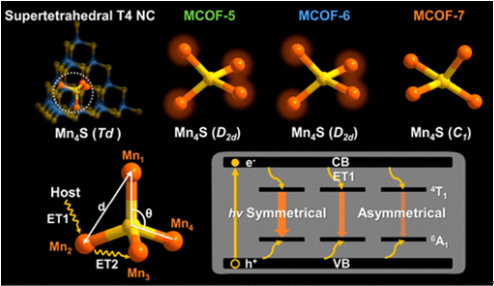New Insights into Mn−Mn Coupling Interaction-Directed Photoluminescence Quenching Mechanism in Mn2+-Doped Semiconductors
Yong Liu1¶, Jiaxu Zhang1¶, Bing Han1, Xiang Wang1, Zhiqiang Wang1, Chaozhuang Xue1, Guoqing Bian1, Dandan Hu1, Rui Zhou1, Dong-Sheng Li2, Zhenxing Wang3, Zhongwen Ouyang3, Mingde Li4, and Tao Wu1*(吴涛)
1College of Chemistry, Chemical Engineering and Materials Science, Soochow University, Suzhou, Jiangsu 215123, China
2College of Materials and Chemical Engineering, Hubei Provincial Collaborative Innovation Center for New Energy Microgrid, Key Laboratory of Inorganic Nonmetallic Crystalline and Energy Conversion Materials, China Three Gorges University, Yichang, Hubei 443002, China
3Wuhan National High Magnetic Field Center & School of Physics, Huazhong University of Science and Technology, Wuhan 430074, China
4Department of Chemistry and Key Laboratory for Preparation and Application of Ordered Structural Materials of Guangdong Province, Shantou University, Shantou, Guangdong 515000, China
¶Y.L. and J.Z. contributed equally
J. Am. Chem. Soc.2020,142, 6649--6660
Strong Mn–Mn coupling interactions (dipole–dipole and spin–exchange), predominantly determined by statistically and apparently short Mn···Mn distances in traditional heavily Mn2+-doped semiconductors, can promote energy transfer within randomly positioned and close-knit Mn2+ pairs. However, the intrinsic mechanism on controlling Mn2+ emission efficiency is still elusive due to the lack of precise structure information on local tetrahedrally coordinated Mn2+ ions. Herein, a group of Mn2+-containing metal–chalcogenide open frameworks (MCOFs), built from [Mn4In16S35] nanoclusters (denoted T4-MnInS) with a precise [Mn4S] configuration and length-variable linkers, were prepared and selected as unique models to address the above-mentioned issues. MCOF-5 and MCOF-6 that contained a symmetrical [Mn4S] core with a D2d point group and relatively long Mn···Mn distance (∼3.9645 Å) exhibited obvious red emission, while no room-temperature PL emission was observed in MCOF-7 that contained an asymmetric [Mn4S] configuration with a C1 point group and relatively short Mn···Mn distance (∼3.9204 Å). The differences of Mn–Mn dipole–dipole and spin–exchange interactions were verified through transient photoluminescent spectroscopy, electron spin resonance (ESR), and magnetic measurements. Compared to MCOF-5 and MCOF-6 showing a narrower/stronger ESR signal and longer decay lifetime of microseconds, MCOF-7 displayed a much broader/weaker ESR signal and shorter decay lifetime of nanoseconds. The results demonstrated the dominant role of distance-directed Mn–Mn dipole–dipole interactions over symmetry-directed spin–exchange interactions in modulating PL quenching behavior of Mn2+ emission. More importantly, the reported work offers a new pathway to elucidate Mn2+-site-dependent photoluminescence regulation mechanism from the perspective of atomically precise nanoclusters.

链接:https://pubs.acs.org/doi/10.1021/jacs.0c00156